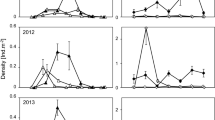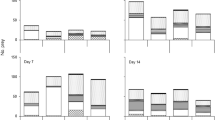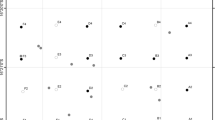Summary
The influence of seasonal availability of two critical resources (food and substrates from which food was harvested) on interspecific competition between striped surfperch (Embiotoca lateralis) and black surfperch (Embiotoca jacksoni) was examined. There was a strong depth-related gradient in density of prey and in cover of foliose algae; both declined with increasing bottom depth. Density of prey was reduced 5–10 fold during the winter season, but cover of substrates remained constant throughout the year. Although both fishes co-occurred throughout the same depth range, striped surfperch were more common in shallow habitats and black surfperch were more abundant deeper. Local abundance and distribution patterns of both surfperch species did not change seasonally. Stepwise regression analyses suggested that availability of favored substrates was a proximate influence on local patterns of surfperch distribution and abundance, and that interspecific competition depressed abundance of the two species to the same degree. Removal experiments conducted during the cold-water season revealed that interspecific competition influenced depth distribution of black surfperch but not striped surfperch. Seasonal change in density of prey was accompanied by marked changes in overlap in use of foraging substrates by the surfperches. The pattern of change in interspecific overlap suggested that surfperch competed for food only when prey were seasonally scarce. There was no difference in the agonistic tendencies of the two fishes, and the absolute and relative frequency of interspecific chases was independent of food level. These results have important implications regarding the impact of temporal variability of interspecific competition in natural communities. In the surfperch system, competition was characterized by constant and time-varying elements that had symmetrical and asymmetrical effects and involved both interference and exploitation mechanisms.
Similar content being viewed by others
References
Branch GM (1984) Competition between marine organisms: ecological and evolutionary implications. Oceanogr Mar Biol Ann Rev 22:429–593
Chesson J (1978) Measuring preference in selective predation. Ecology 59:211–215
Chesson J (1983) The estimation and analysis of preference and its relationship to foraging models. Ecology 64:1297–1304
Connell JH (1970) A predator-prey system in the marine intertidal region. J. Balanus glandula and several predatory species of Thais. Ecol Monogr 40:49–78
Connell JH (1975) Some mechanisms producing structure in natural communities. In: Cody ML, Diamond JM (eds), Ecology and evolution of communities. Belknap Press, Harvard Univ, Cambridge, pp 460–490
Connell JH (1983) On the prevalence and relative importance of interspecific competition: evidence from field experiments. Amer Natur 122:661–696
Connell JH (1985) The consequences of variation in initial settlement vs. post-settlement mortality in rocky intertidal communities. J Exp Mar Biol Ecol 93:11–45
Dayton PK (1971) Competition, disturbance and community organization: the provision and subsequent utilization of spece in a rocky intertidal community. Ecol Monogr 41:351–389
Diamond JM (1978) Niche shifts and the rediscovery of interspecific competition. Amer Sci 66:322–331
Dunham AE (1980) An experimental study of interspecific competition between the iguanid lizards Sceloporus merriami and Urosaurus ornatus. Ecol Monogr 50:309–330
Ebeling AW, Larson RJ, Alevizon WS, Bray RN (1980) Annual variability of reef-fish assemblages in kelp forests off Santa Barbara, California. Fishery Bull 78:361–377
Ebeling AW, Laur DR (1986) Foraging in surfperches: resource partitioning or individualistic responses? Envir Biol Fish 16:123–133
Ebeling AW, Laur DR, Rowley RJ (1985) Severe storm disturbances and reversal of community structure in a southern California kelp forest. Mar Biol 84:287–294
Feinsinger P, Swarm LA (1982) “Ecological release”, seasonal variation in food supply, and the hummingbird Amazilia tobaci on Trinidad and Tobago. Ecology 63:1574–1587
Feinsinger, P, Spears EE, Poole RW (1981) A simple measure of niche breadth. Ecology 62:27–32
Hixon MA (1980) Competitive interactions between California reef fishes of the genus Embiotoca. Ecology 61:918–931
Holbrook SJ, Schmitt RJ (1984) Experimental analyses of patch selection by foraging black surfperch (Embiotoca jacksoni). J Exp Mar Biol Ecol 79:39–64
Holbrook SJ, Schmitt RJ (1986) Food acquisition by competing surfperch on a patchy environmental gradient. Envir Biol Fish 16:135–146
Keough MJ (1984) Dynamics of the epifauna of the bivalve Pinna bicolor: interactions between recruitment, predation, and competition. Ecology 65:677–688
Kephart DG, Arnold SJ (1982) Garter snake diets in a fluctuating environment: a seven year study. Ecology 63:1232–1236
Larson RJ (1977) Habitat selection and territorial competition as the causes of bathymetric segregation of sibling rockfishes (Sebastes). PhD dissertation. Univ Calif Santa Barbara
Larson RJ (1980) Competition, habitat selection, and bathymetric segregation of two rockfish (Sebastes) species. Ecol Monogr 50:221–239
Laur DF, Ebeling AW (1983) Predator-prey relationships in a guild of surfperches. Env Biol Fish 8:217–229
Lynch M (1978) Complex interactions between natural coexploiters — Daphnia and Ceriodaphnia. Ecology 59:552–564
Manly BFJ (1974) A model for certain types of selection experiments. Biometrics 30:281–294
Morris RD, Grant PR (1972) Experimental studies of competitive interaction in a two-species system. IV. Microtus and Clethrionomys species in a single enclosure. J Anim Ecol 41:275–290
Pianka ER (1981) Competition and niche theory. In: May RM (eded) Theoretical ecology. W.B. Saunders Co, pp 114–141
Pimm SL, Pimm JW (1982) Resource use, competition, and resource availability in Hawaiian honeycreepers. Ecology 63:1468–1480
Quinn JF, Dunham AE (1983) Hypothesis testing in ecology and evolution. Amer Natur 122:602–617
Roughgarden J (1983) Competition and theory in community ecology. Amer Natur 122:583–601
Schlosser IJ, Toth LA (1984) Niche relationships and population ecology of rainbow (Etheostoma caeruleum) and fantail (E. flabellare) darters in a temporally variable environment. Oikos 42:229–238
Schluter D (1982) Distributions of Galapagos ground finches along an altitudinal gradient: the importance of food supply. Ecology 63:1504–1517
Schmitt RJ, Coyer JA (1982) The foraging ecology of sympatric marine fish in the genus Embiotoca (Embiotocidae): importance of foraging behavior in prey size selection. Oecologia 55:369–378
Schmitt RJ, Coyer JA (1983) Variation in surfperch diets between allopatry and sympatry: circumstantial evidence for competition. Oecologia 58:402–410
Schmitt RJ, Holbrook SJ (1984a) Gape-limitation, foraging tactics and prey size selectivity of two microcarnivorous species of fish. Oecologia 63:6–12
Schmitt RJ, Holbrook SJ (1984b) Ontogeny of prey selection by black surfperch, Embiotoca jacksoni (Pisces: Embiotocidae): the roles of fish morphology, foraging behavior, and patch selection. Mar Biol Progr Ser 18:225–239
Schoener TW (1983) Field experiments on interspecific competition. Amer Natur 122:240–285
Schoener TW (1985) Some comments on Connell's and my reviews of field experiments on interspecific competition. Amer Natur 125:730–740
Simberloff D (1983) Competition theory, hypothesis testing, and other community ecological buzzwords. Amer Natur 122:626–635
Smith DC (1981) Competitive interactions of the striped plateau lizard (Sceloporus virgatus) and the trec lizard (Urosaurus ornatus) Ecology 62:679–687
Strong DR Jr (1983) Natural variability and the manifold mechanisms of ecological communities. Amer Natur 122:636–660
Sutherland JP (1978) Functional roles of Schizoporella and Styela in the fouling community at Beaufort, North Carolina. Ecology 59:257–264
Underwood AJ, Denley EJ (1983) Paradigms, explanations and generalizations in models for the structure of intertidal communities on rocky shores. In: Strong DR Jr, Simberloff D, Abele LG, Thistle AB (eds) Ecological communities: conceptual issues and the evidence. Princeton Univ Press, Princeton, NJ
Werner EE, Mittelbach GG, Hall DJ, Gilliam JF (1983) Experimental tests of optimal habitat use in fish: the role of relative habitat profitability. Ecology 64:1525–1539
Wiens JA (1977) On competition and variable environments. Amer Sci 65:590–597
Author information
Authors and Affiliations
Rights and permissions
About this article
Cite this article
Schmitt, R.J., Holbrook, S.J. Seasonally fluctuating resources and temporal variability of interspecific competition. Oecologia 69, 1–11 (1986). https://doi.org/10.1007/BF00399030
Received:
Issue Date:
DOI: https://doi.org/10.1007/BF00399030




